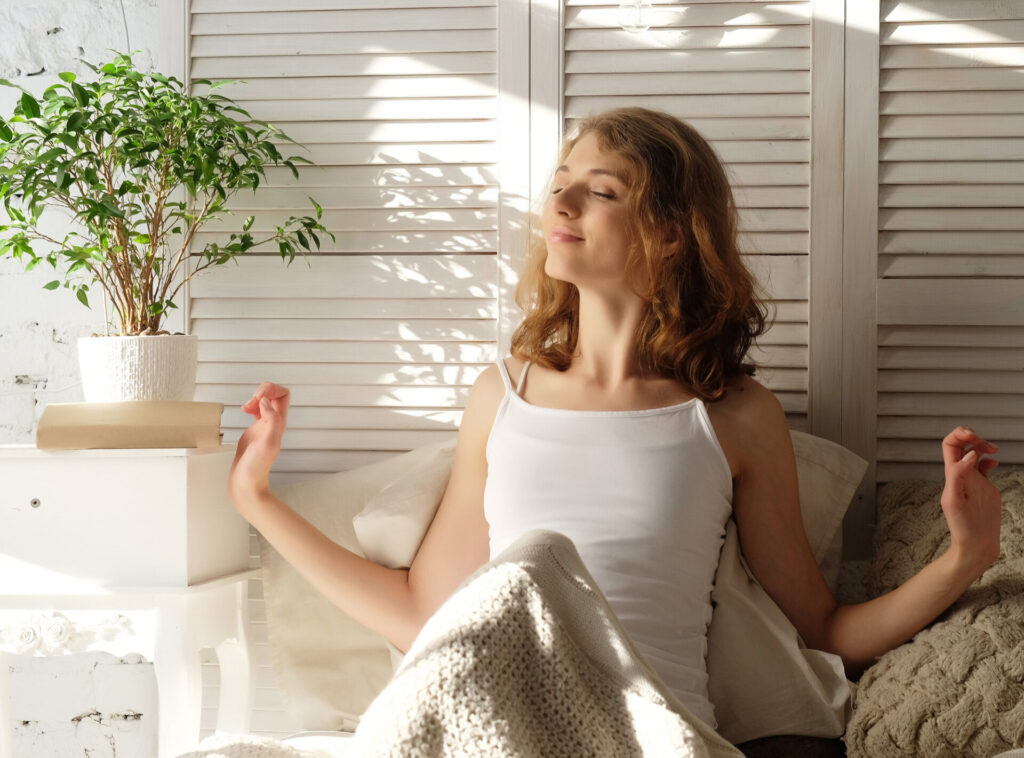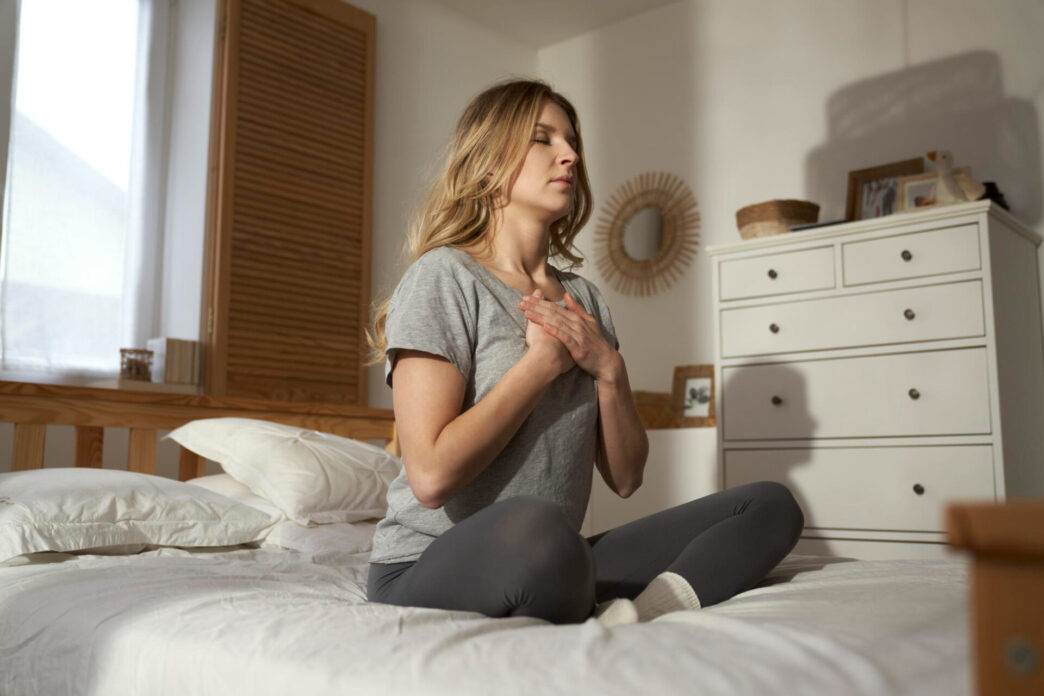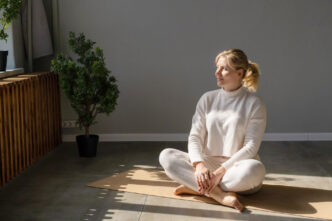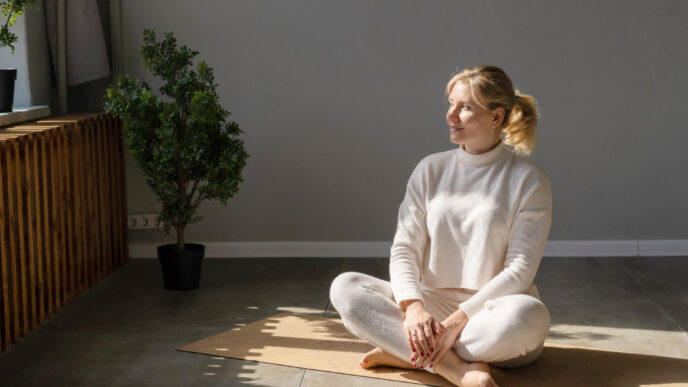Breathe Your Way Out of Stress 😌
Stress is no longer a rare guest—it’s become a daily companion for many. Whether it’s the pressure of deadlines, endless notifications, or sleepless nights, our nervous systems are constantly on high alert. But what if the way out of this loop is as close as your next breath?
Deep breathing for stress relief isn’t just a wellness trend—it’s a science-backed, practical method to calm your mind, balance your emotions, and restore your energy in just a few minutes a day. With zero equipment, no side effects, and instant accessibility, your breath can become your most powerful self-regulation tool.
“One deep breath is the beginning of inner peace.”
And here’s the best part: the benefits go beyond just stress. The right breathing techniques can help with:
✔️ Easing anxiety during tense moments
✔️ Falling asleep faster and staying asleep longer
✔️ Improving mental clarity and focus without caffeine
✔️ Increasing emotional resilience in everyday life
Let’s be clear—this isn’t about taking random deep breaths whenever you remember. You’re about to discover specific, proven breathing techniques for anxiety, better sleep, laser focus, and overall emotional wellness. These methods are simple, effective, and life-enhancing.
🧘♂️ Ready to take control of your inner state with nothing but your breath?
Let’s dive into how and why deep breathing works—starting with the powerful connection between your breath and your nervous system.
The Power of Deep Breathing
How Breathing Affects the Nervous System
Breathing is more than just a biological function—it’s a direct gateway to our nervous system. Our body operates under two primary states governed by the autonomic nervous system:
- Sympathetic Nervous System (SNS): The “fight or flight” mode, triggered by stress and danger. It increases heart rate, blood pressure, and cortisol levels.
- Parasympathetic Nervous System (PNS): The “rest and digest” mode, which promotes relaxation, lowers heart rate, and helps in healing and digestion.
Deep breathing activates the vagus nerve, which stimulates the PNS, shifting the body into a state of relaxation. This shift reduces stress hormones, enhances mental clarity, and improves emotional balance.
Scientific Insight:
Studies show that slow, deep breathing can reduce cortisol levels by up to 20%, helping the body manage stress more effectively. It also increases heart rate variability (HRV), a key marker of cardiovascular health and emotional resilience.
Benefits of Conscious Breathing
Mastering deep breathing offers a wide range of benefits, from physical to emotional well-being:
✔️ Reduces Stress & Anxiety – Lowers cortisol and activates the relaxation response.
✔️ Enhances Mental Clarity – Improves focus, cognitive function, and decision-making.
✔️ Lowers Blood Pressure – Encourages vasodilation, reducing strain on the heart.
✔️ Improves Sleep Quality – Helps release tension and promote relaxation before bed.
✔️ Boosts Immune Function – Supports lymphatic drainage and oxygenates the blood.
✔️ Enhances Emotional Regulation – Helps manage anger, fear, and frustration effectively.
✔️ Increases Lung Capacity – Strengthens respiratory muscles and improves oxygen exchange.
“When you own your breath, nobody can steal your peace.”
Practicing conscious breathing daily can profoundly impact your health and quality of life. Next, let’s explore practical techniques you can start using today.

Fundamental Breathing Techniques
Diaphragmatic Breathing (Belly Breathing)
How it works: This technique engages the diaphragm fully, allowing deep inhalation and optimal oxygen exchange.
Steps:
- Sit or lie down in a comfortable position.
- Place one hand on your chest and the other on your belly.
- Inhale deeply through your nose, allowing your belly to expand while keeping your chest still.
- Exhale slowly through your mouth, feeling your belly deflate.
- Repeat for 5–10 minutes.
Best for: Stress relief, relaxation, and lung capacity improvement.
Box Breathing (Four-Square Breathing)
How it works: This method, often used by Navy SEALs, enhances focus and relaxation by balancing oxygen and carbon dioxide levels.
Steps:
- Inhale through your nose for 4 seconds.
- Hold your breath for 4 seconds.
- Exhale through your mouth for 4 seconds.
- Hold your breath again for 4 seconds.
- Repeat for 5–7 rounds.
Best for: Enhancing focus, reducing anxiety, and improving emotional regulation.
4-7-8 Breathing Method
How it works: A powerful technique for calming the mind and preparing the body for sleep.
Steps:
- Inhale through your nose for 4 seconds.
- Hold your breath for 7 seconds.
- Exhale slowly through your mouth for 8 seconds.
- Repeat for 4–6 cycles.
Best for: Falling asleep faster, reducing anxiety, and deep relaxation.
Alternate Nostril Breathing (Nadi Shodhana)
How it works: A traditional yogic practice that balances both hemispheres of the brain and enhances mental clarity.
Steps:
- Sit comfortably and use your right thumb to close your right nostril.
- Inhale deeply through your left nostril.
- Close your left nostril with your ring finger and release the right nostril.
- Exhale through the right nostril.
- Inhale through the right nostril, then switch and exhale through the left.
- Repeat for 5 minutes.
Best for: Mental clarity, stress relief, and balancing energy levels.
Deep Breathing for Stress Reduction
How Breathing Can Alleviate Anxiety
Anxiety triggers the fight-or-flight response, causing shallow, rapid breathing, an increased heart rate, and heightened muscle tension. This reaction is useful in emergencies but harmful when experienced chronically.
Deep breathing counteracts anxiety by:
✔️ Activating the parasympathetic nervous system, which slows heart rate and lowers blood pressure.
✔️ Regulating carbon dioxide levels, preventing dizziness and hyperventilation.
✔️ Reducing cortisol, the stress hormone responsible for tension and worry.
✔️ Enhancing oxygenation, improving cognitive function and emotional stability.
Scientific Insight:
A 2020 study published in Frontiers in Psychology found that practicing deep breathing for just 5 minutes daily significantly reduced symptoms of anxiety and improved overall emotional resilience.
Using Breathing to Manage Daily Stress
You don’t need a quiet meditation space to practice deep breathing—integrating it into your daily routine is easy.
✔️ At Work: Before responding to stressful emails, take three slow, deep breaths.
✔️ In Traffic: Try box breathing at a red light to maintain calmness.
✔️ Before Sleep: Practice 4-7-8 breathing to release tension from the day.
✔️ During Exercise: Synchronize breathing with movement to enhance endurance and relaxation.
Simple Stress-Relief Breathing Routine (2 minutes):
- Inhale deeply through your nose for 4 seconds.
- Hold for 4 seconds.
- Exhale slowly through your mouth for 6 seconds.
- Repeat 5 times.
Even short breathing exercises can create a noticeable shift in stress levels, helping you regain control in challenging moments.
Breathing Exercises for Panic Attacks
During a panic attack, the body enters extreme fight-or-flight mode, leading to hyperventilation, dizziness, and rapid heartbeat. Controlled breathing helps break this cycle.
Best Techniques to Stop a Panic Attack:
✔️ Extended Exhale Technique: Focus on exhaling longer than you inhale. Try breathing in for 4 seconds and exhaling for 8 seconds to reset the nervous system.
✔️ Grounding with 5-5-5 Breathing: Inhale for 5 seconds, hold for 5 seconds, and exhale for 5 seconds to regain stability.
✔️ Hand-on-Heart Method: Place your hand on your heart, inhale deeply through your nose, and exhale with a sigh to send a signal of safety to your brain.
“Inhale peace, exhale stress. Your breath is always within your control.”
By mastering these techniques, you can interrupt the panic cycle, regain calm, and prevent future attacks more effectively.

Breathing for Better Sleep
Evening Breathing Routines
Struggling to fall asleep? Deep breathing helps transition the body from wakefulness to rest by lowering heart rate, relaxing muscles, and signaling the brain to release melatonin, the sleep hormone.
Effective Pre-Sleep Breathing Techniques:
✔️ 4-7-8 Method – A natural sedative effect on the nervous system.
✔️ Diaphragmatic Breathing – Releases built-up tension from the day.
✔️ Progressive Exhalation – Lengthen each exhale slightly to ease into sleep.
Quick 5-Minute Sleep Routine:
- Lie in bed with your eyes closed.
- Inhale through your nose for 4 seconds.
- Hold for 7 seconds.
- Exhale completely for 8 seconds.
- Repeat for 5 cycles, allowing your body to soften with each breath.
How Deep Breathing Induces Relaxation Before Bed
Deep breathing reduces the hyperactivity of the mind and promotes full-body relaxation. This effect makes it particularly helpful for:
✔️ Insomnia – Slows brain activity, making it easier to drift off.
✔️ Racing Thoughts – Provides an anchor for mental stillness.
✔️ Nighttime Anxiety – Lowers cortisol and prevents stress-induced wakefulness.
Scientific Insight:
A study in Sleep Medicine Reviews found that deep breathing before bed improved sleep quality and reduced nighttime awakenings by 30% in participants with insomnia.
Boosting Focus and Energy with Breathing
Breathing Techniques for Clarity and Productivity
Mental fog, lack of concentration, and fatigue often stem from shallow breathing and poor oxygenation. Deep breathing improves cognitive function by increasing oxygen flow to the brain, sharpening focus, and reducing mental fatigue.
How Oxygen Affects the Brain:
✔️ Enhances mental clarity – More oxygen means better brain performance.
✔️ Increases alertness – Stimulates the nervous system to maintain wakefulness.
✔️ Improves memory recall – Aids in retaining and retrieving information.
✔️ Reduces mental fatigue – Keeps you refreshed without relying on caffeine.
Best Breathing Techniques for Focus:
✔️ Bellows Breath (Bhastrika Pranayama): Rapid, forceful breathing that energizes the mind.
✔️ Box Breathing: Balances the nervous system, preventing mental overload.
✔️ Alternate Nostril Breathing: Clears mental fog and enhances cognitive function.
Morning Breathing Rituals to Start the Day Right
Instead of reaching for coffee first thing in the morning, try energizing breathing exercises to kickstart your system naturally.
Simple Morning Breathing Routine (5 minutes):
- Bellows Breath: Inhale forcefully through the nose, exhale rapidly (repeat 20 times).
- Deep Diaphragmatic Breathing: Inhale for 5 seconds, hold for 5, exhale for 5 (repeat 5 times).
- Sunlight + Breath: Step outside, breathe deeply, and let natural light reset your circadian rhythm.
Scientific Insight:
Studies show that oxygenating the brain through deep breathing in the morning increases alertness by 30% and improves mood regulation.
Breathing in Meditation and Mindfulness
The Role of Breath in Meditation Practices
Breath is the anchor of meditation. By focusing on breathing patterns, we train the mind to remain present, reducing mental distractions.
How Breathing Enhances Meditation:
✔️ Calms the racing mind – Helps transition into a meditative state.
✔️ Deepens awareness – Makes mindfulness practice more effective.
✔️ Stabilizes emotions – Helps navigate stress, anxiety, and tension.
Best Breathing Techniques for Meditation:
✔️ Counting the Breath: Focus on inhaling for 4 seconds, exhaling for 6.
✔️ Breath Awareness Meditation: Simply observe your breath without controlling it.
✔️ Mantra & Breath Synchronization: Repeat a word (e.g., “peace”) with each inhale and exhale.
Quote:
“Your breath is your greatest ally in achieving inner peace.” — Thich Nhat Hanh
Breathing Exercises for Mindful Awareness
Practicing mindful breathing helps integrate meditation into daily life without needing a dedicated space.
✔️ 1-Minute Mindfulness Breath: Take three slow, deep breaths before a meeting, meal, or transition.
✔️ Walking Breath Awareness: Match your breath to each step while walking.
✔️ Mindful Pauses: Whenever you feel overwhelmed, take a long inhale and slow exhale to reset.

Incorporating Deep Breathing into Daily Life
Making Breathing a Habit
Consistency is key. To reap the full benefits of deep breathing, integrate it into your daily routine.
How to Make It a Daily Practice:
✔️ Set Reminders: Use phone alarms or sticky notes as breath-check triggers.
✔️ Pair with Existing Habits: Breathe deeply before meals, before bed, or after waking up.
✔️ Track Progress: Use a mindfulness app to monitor breathing exercises.
Simple Practices for Work, Home, and Travel
No matter where you are, there’s always time to breathe deeply.
✔️ At Work: Practice box breathing between tasks.
✔️ At Home: Use 4-7-8 breathing to unwind after a long day.
✔️ While Traveling: Try alternate nostril breathing to manage travel anxiety.
Quote:
“Breath is the link between the mind and body. Control it, and you control your life.” — Unknown
Conclusion
Deep breathing is a simple yet powerful tool that can transform your mental, physical, and emotional well-being. By practicing breathing techniques daily, you can:
✔️ Reduce stress and anxiety
✔️ Improve focus and clarity
✔️ Enhance sleep quality
✔️ Boost energy levels naturally
✔️ Strengthen emotional regulation
Final Thought:
Start small—just five minutes of deep breathing a day can make a profound difference. Breathe deeply, live fully, and find serenity in every inhale and exhale.
References and Inspirational Resources
- Jerath, R., Edry, J. W., Barnes, V. A., & Jerath, V. Physiology of long pranayamic breathing: Neural respiratory elements may provide a mechanism that explains how slow deep breathing shifts the autonomic nervous system. Medical Hypotheses.
- Brown, R. P., & Gerbarg, P. L. Sudarshan Kriya yogic breathing in the treatment of stress, anxiety, and depression: Part II—clinical applications and guidelines. Journal of Alternative and Complementary Medicine.
- Harvard Health Publishing – Relaxation techniques: Breath control helps quell errant stress response. Harvard Medical School.
- The American Institute of Stress – Articles and guides on breathing techniques for stress relief and anxiety reduction.
- National Center for Complementary and Integrative Health (NCCIH) – Meditation and Mindfulness: What You Need To Know.
- Psychology Today – Articles on mindful breathing, emotional regulation, and anxiety management.
- Healthline – 6 Breathing Exercises for Anxiety. Evidence-based breathing practices for calming the mind and body.















